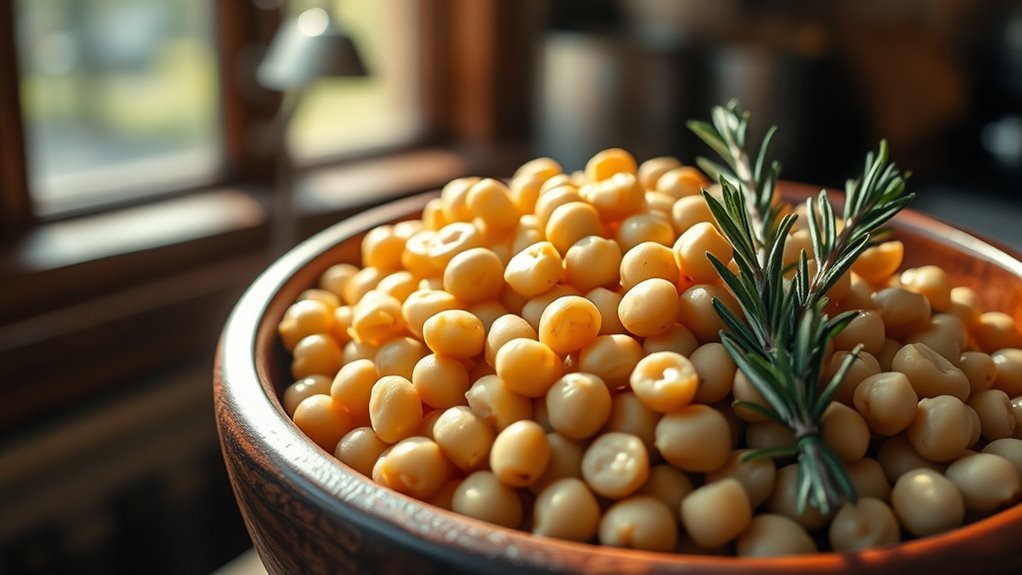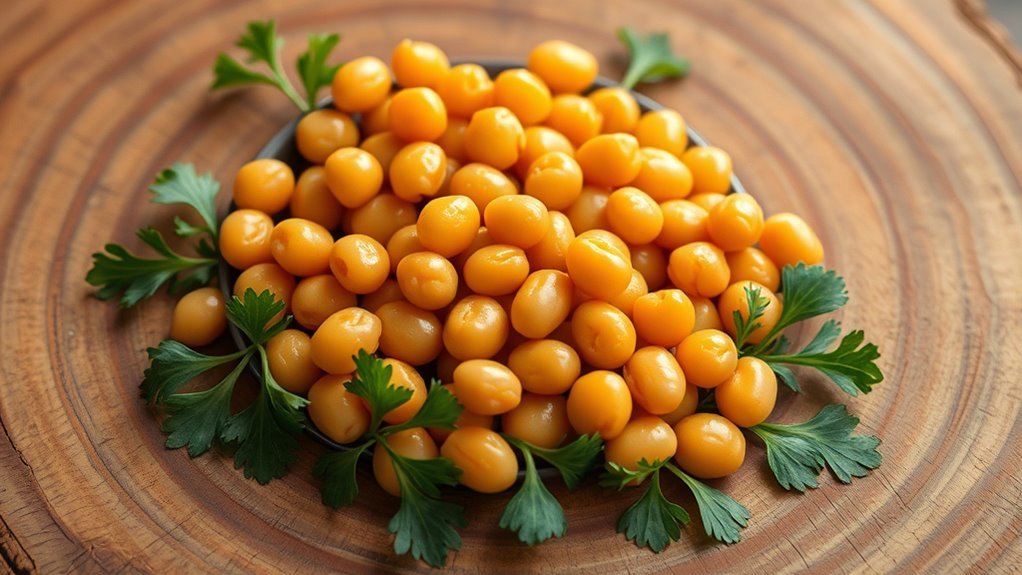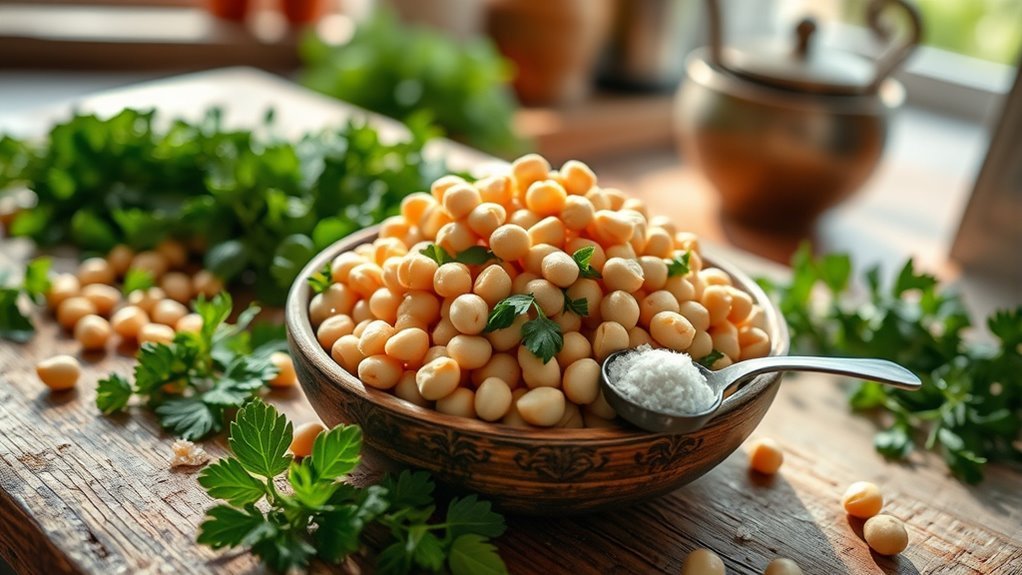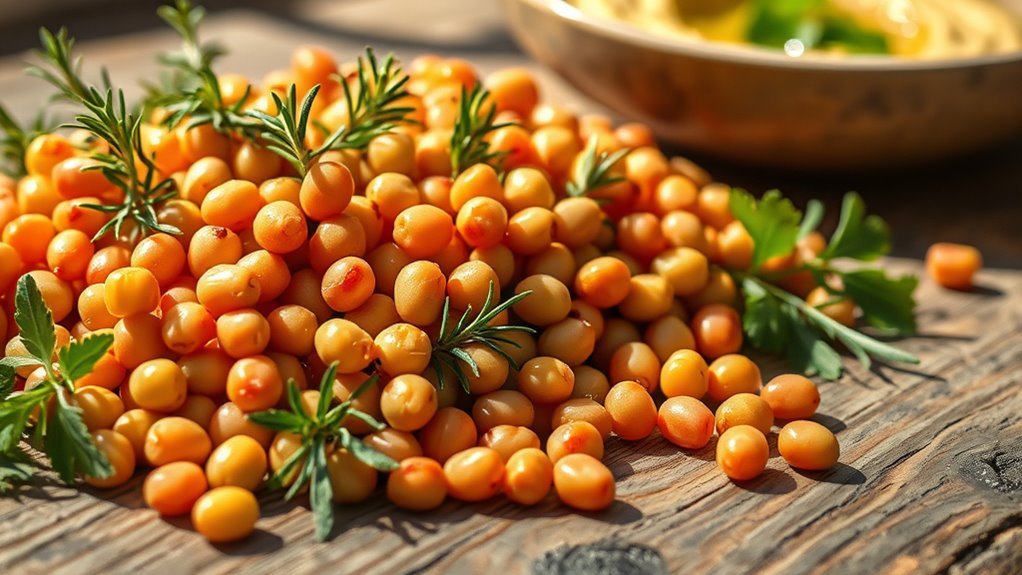Garbanzo beans aren’t considered keto-friendly due to their high carbohydrate content. A typical serving has around 45 grams of carbs, which can disrupt ketosis. While they offer health benefits like fiber and essential nutrients, large amounts may lead to glucose spikes. If you’re following a strict keto diet, it’s better to choose low-carb alternatives instead. There are plenty of options that can support your dietary needs while keeping you in ketosis, so let’s explore them further.
Understanding the Ketogenic Diet

While you may have heard of various diets promising quick weight loss, the ketogenic diet stands out for its focus on drastically reducing carbohydrate intake to promote fat burning. At its core, the ketogenic principles center around high fat, moderate protein, and very low carbohydrates. This unique macronutrient composition encourages your body to enter a state of ketosis, where it burns fat for fuel instead of glucose. As you adapt to this new energy source, you’ll experience fat adaptation, which can lead to improved energy levels and appetite control. However, it’s essential to approach the ketogenic diet mindfully, ensuring you’re consuming nutrient-dense foods to support overall health. By understanding these foundational concepts, you can make informed choices about your dietary journey.
Nutritional Profile of Garbanzo Beans

Garbanzo beans, also known as chickpeas, are often celebrated for their nutritional benefits, but their carbohydrate content raises questions for those following a ketogenic diet. These legumes boast impressive nutrient density, providing essential vitamins and minerals like folate, iron, and magnesium. They’re also a great source of plant-based protein and dietary fiber. The balance of nutrients in garbanzo beans can support overall health, promoting satiety and aiding digestion. While their high fiber content is beneficial for gut health, it’s vital to contemplate how they fit into your daily carb allowance on a keto plan. By understanding their nutritional profile, you can make informed choices that align with your health goals while enjoying the versatility of garbanzo beans.
Carb Content of Garbanzo Beans

When considering garbanzo beans in a keto diet, it’s crucial to look at their carb content. You’ll want to understand the concept of net carbs, which is the total carbohydrates minus fiber, as this impacts your daily intake. A nutritional breakdown reveals how these beans fit into your overall carb allowance while providing valuable nutrients.
Net Carbs Explained
Understanding net carbs is essential for anyone following a ketogenic diet, especially since different foods can vary greatly in their carbohydrate content. When considering garbanzo beans, it’s important to focus on net carb calculations, which subtract fiber content from total carbohydrates. This is because fiber isn’t fully digested and doesn’t spike blood sugar levels. In a typical serving of garbanzo beans, the total carbohydrates can seem high, but when you account for fiber, the net carbs become considerably lower. This allows you the freedom to enjoy foods that may seem off-limits. Always remember to check the specific serving sizes and the fiber content to make informed decisions that align with your keto goals.
Nutritional Breakdown Overview
Although garbanzo beans are often praised for their nutritional profile, it is crucial to examine their carbohydrate content closely, especially for those on a ketogenic diet. A typical serving size (about 1 cup cooked) contains roughly 45 grams of carbohydrates, which can be significant. However, their high dietary fiber (around 12 grams) reduces net carbs, making them slightly more manageable for low-carb eaters. Beyond carbs, garbanzo beans boast a robust protein content, a rich vitamin profile, and valuable minerals. Their calorie count is around 269 per cup, depending on cooking methods. While the health impacts are generally positive, moderation is key, particularly on a strict keto regimen. Always consider your individual dietary needs when incorporating garbanzo beans into your meals.
Health Benefits of Garbanzo Beans
Garbanzo beans, also known as chickpeas, offer a wealth of health benefits that can enhance your diet, especially if you’re looking for plant-based protein sources. They’re rich in fiber, which supports digestive health and helps you feel fuller longer. This can aid in weight management—a critical health consideration. Their nutritional advantages include a variety of vitamins, minerals, and antioxidants, promoting heart health and regulating blood sugar levels. Additionally, garbanzo beans contain essential amino acids, making them a valuable protein source for vegetarians and vegans. Incorporating them into your meals can diversify your diet while providing sustained energy. Just be mindful of portion sizes if you’re following a strict ketogenic approach, as they can be higher in carbs compared to other legumes.
Comparing Garbanzo Beans to Other Legumes
When comparing garbanzo beans to other legumes, it’s important to contemplate their nutritional profiles and how they fit into various dietary plans. Garbanzo beans, like other legume varieties such as lentils and black beans, are excellent plant-based protein sources. However, they differ in carbohydrate content, fiber, and micronutrients. For instance, lentils tend to be lower in carbs while offering a similar protein punch. Black beans boast higher fiber content, which can aid digestion. Each legume variety has unique qualities, so if you’re considering alternatives to garbanzo beans, think about your dietary goals. Whether you’re seeking protein or fiber, understanding these differences can empower you to make informed choices that align with your nutritional needs and lifestyle preferences.
How Garbanzo Beans Fit Into a Keto Diet
If you’re following a keto diet, understanding how garbanzo beans fit into your meal plan is essential, given their carbohydrate content. While garbanzo beans are nutritious, they contain about 27 grams of carbs per cup, making them a bit challenging for strict keto guidelines, which typically limit daily carb intake to around 20-50 grams. However, if you’re creative, you can incorporate small portions into your diet. Consider using garbanzo bean recipes in moderation or blending them into dips, ensuring you account for the carbs. For keto meal prep, focus on balancing these beans with low-carb vegetables and healthy fats to maintain ketosis while enjoying the flavors and benefits they offer. Just be mindful of your overall carb intake!
Alternative Low-Carb Options
If you’re looking for low-carb alternatives to garbanzo beans, zucchini noodles and cauliflower rice can be great options. Zucchini noodles are not only low in carbs but also provide a satisfying texture for your favorite pasta dishes. Meanwhile, cauliflower rice serves as a versatile substitute that can complement various meals while keeping your carb intake in check.
Zucchini Noodles Benefits
While many are searching for low-carb alternatives to traditional pasta, zucchini noodles, often called “zoodles,” present a nutritious option that aligns well with keto and other low-carb diets. Zucchini noodles are low in calories and carbs, making them a fantastic pasta alternative for those wanting to maintain a healthy lifestyle. Packed with vitamins and minerals, they can easily be incorporated into various healthy recipes, adding essential nutrients to your meals. Zoodles can absorb flavors well, allowing you to enjoy a flavorful low carb dish without the guilt of traditional pasta. By swapping out regular noodles for zucchini, you’re not just cutting carbs but also boosting your vegetable intake, giving you the freedom to indulge without compromising your health goals.
Cauliflower Rice Alternatives
As you explore low-carb options, you might consider alternatives to cauliflower rice that can still satisfy your cravings for a hearty base in your meals. Broccoli rice is a popular substitute, offering similar texture and low carbs, plus additional vitamins. Cabbage rice is another great choice; it’s low-calorie and packed with fiber. If you’re looking for something more unique, consider using shredded turnips or mushrooms, both of which can add rich flavors to your dishes. Each of these alternatives carries its own benefits, just like cauliflower rice does. You can find plenty of cauliflower rice recipes that can be adapted to include these options, allowing you to enjoy the health benefits of varied low-carb ingredients while keeping your meals exciting and diverse.
Creative Ways to Use Garbanzo Beans
Garbanzo beans, also known as chickpeas, can be incredibly versatile in your kitchen, especially if you’re looking to incorporate more plant-based proteins into your diet. You can whip up creative hummus recipes by blending garbanzo beans with flavors like roasted red pepper or garlic, providing a unique twist on a classic dip. Additionally, consider making savory chickpea salads by mixing them with fresh vegetables, herbs, and a zesty dressing; it’s a revitalizing option for lunch or dinner. You might even try roasting garbanzo beans for a crunchy snack, seasoned with your favorite spices. These ideas not only enhance your meals but also help you enjoy the nutritional benefits of garbanzo beans without sacrificing taste or variety.
Potential Downsides of Eating Garbanzo Beans on Keto
While garbanzo beans offer nutritional benefits, their high carbohydrate content can be a concern for those on a keto diet. Eating them may also impact your blood sugar levels, which is something to contemplate if you’re monitoring your glucose. Additionally, some people might experience digestive issues due to the fiber content, which could affect your overall comfort on keto.
High Carb Content
Many people following a ketogenic diet may be surprised to learn that garbanzo beans, despite their nutritional benefits, can pose challenges due to their high carbohydrate content. If you’re aiming for ketosis, consider the following:
- Carb Count: Garbanzo beans contain about 27 grams of carbs per cup, which can quickly consume your daily limit.
- Portion Control: Even small servings can add up, making it difficult to stay within your carb allowance.
- Carb Alternatives: Exploring other low-carb options, like zucchini or cauliflower, can help you maintain your ketogenic goals without sacrificing flavor or nutrition.
While garbanzo beans are nutritious, their high carb content may not align with your keto lifestyle, so it’s essential to weigh your options carefully.
Blood Sugar Impact
When considering the impact of garbanzo beans on blood sugar levels, it’s important to recognize that their carbohydrate content can lead to potential spikes in glucose, especially for those on a ketogenic diet. Consuming garbanzo beans may trigger an insulin response, which could disrupt the state of ketosis you aim to maintain. While they provide protein and fiber, the carbs can still affect your blood sugar, making it vital to monitor your intake. If you’re mindful of your daily carb limit, you might find that even small portions can have a notable effect. Balancing the benefits of garbanzo beans with their potential to elevate blood sugar is key to making informed dietary choices while pursuing a keto lifestyle.
Digestive Issues Risks
Although garbanzo beans are a nutritious source of protein and fiber, they can pose digestive challenges for some individuals, particularly those following a keto diet. If you’re pondering adding them to your meals, be aware of the potential for gastric discomfort, especially if you have fiber sensitivity. Here are three key points to reflect on:
- Fiber Content: Garbanzo beans are high in fiber, which can lead to bloating or gas if your body isn’t used to it.
- Antinutrients: They contain compounds that may hinder nutrient absorption and further complicate digestion.
- Portion Control: Eating them in large quantities can exacerbate digestive issues, so moderation is essential.
Being mindful of these factors can help you enjoy garbanzo beans without the unwanted side effects.
Final Thoughts on Garbanzo Beans and Keto Compatibility
While garbanzo beans are often celebrated for their nutritional benefits, their compatibility with a keto diet remains a topic of debate. These legumes provide protein, fiber, and necessary vitamins but are relatively high in carbohydrates, which can hinder ketosis. If you’re committed to keto, it’s vital to contemplate alternatives that align better with your goals. Low-carb veggies, nuts, and seeds offer similar nutritional profiles without the carb load. However, if you find yourself craving the unique texture and flavor of garbanzo beans, moderation might be key. You could incorporate them occasionally, ensuring they fit within your daily carb limits. Ultimately, balancing garbanzo benefits with your dietary needs is important for maintaining your keto lifestyle while enjoying food freedom.


